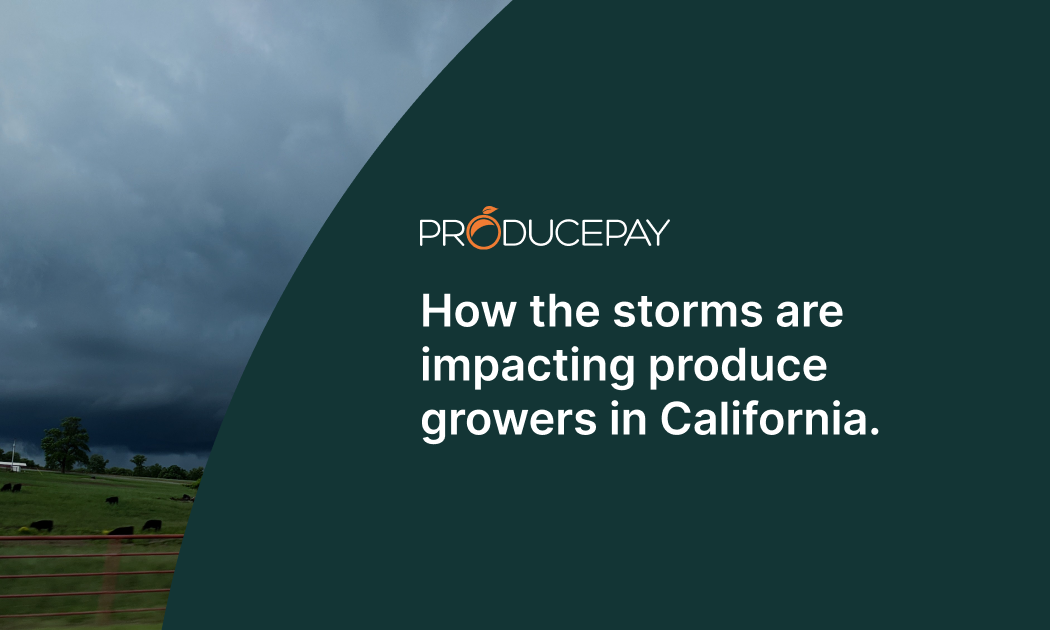
How the storms are impacting produce growers in California.
The past four weeks of heavy storms in California have had mixed impact on the state’s agricultural industry. Depending on the commodity and location, many of the state’s farmers have been able to weather the storm, while others in higher impacted regions are taking stock of the impacts. Others are grateful for the rain after experiencing years of drought in crops such as almonds, pistachios, tomatoes and cotton.
Which commodities have been affected?
The rains have had a positive impact on many drought-stricken crops, but more storms could have serious and adverse consequences. For example:
-
- Strawberry: The strawberry crop started its season on January 23th (with its sights set on Valentine’s Day) but excessive moisture can make it difficult to manage fungi.
-
- Almonds & Pistachio: In the case of some almond and pistachio fields in the San Joaquin Valley, work has been intermittent because of the flooded fields, but since they are dormant, the damage has been minimal. However, if they’re still flooded a few weeks after they’ve been activated, the damage will be serious.
-
- Citrus: In the case of citrus, the fruit can stay on the trees for several weeks, so it hasn’t been a problem.
-
- Vegetables: Other crops that are being affected in the Santa María area are vegetables. Potato and baby lettuce fields were flooded after absorbing 3-5 inches of rain in a short time. However, because the damage occurred in specific regions and crops, there were no large-scale losses.
The Good News: More Water
The main positive effect for agriculture in the state is that reservoir levels are recovering after three years of drought. According to the California Department of Water Resources, as of January 17, 10 of the 17 reservoirs are at or above their historical average, although the remaining 7 are still at half their capacity or less.
In addition, Lake Shasta has risen to record levels, which is important since it is the largest single water reservoir in the state, and is also one of the main sources of water for farming.
The best news, though, is that snowfall across the state is above average for the year and in some areas, even close to the average total for the season, which typically peaks in April. This is positive because there are reservoirs that depend on snowmelt to maintain their levels throughout the year.
Of course, after eight major storms, California’s soil has become saturated and is incapable of absorbing more water, with floods and landslides causing road closures, as well as power outages. Together, these problems are beginning to affect agricultural production, transportation and marketing.
In fact, the California government fears that if it continues to rain, the massive floods of 1861 and 1862, which affected the Central Valley and which are part of the natural cycle in the state, will be repeated. California has implemented an anti-flood plan for the Central Valley, one of the most important agricultural regions of the state.
What can growers and buyers do?
Despite the amount of rain that has fallen, there is insufficient infrastructure in place to store and manage the water. While most of the stormwater will end up in the ocean, the final determination of the availability of surface water for agriculture in California will not be known until April, when state and federal agencies can assess the full impacts of the wet season in reservoirs and calculate expected runoff water from snow.
For growers, these types of weather events represent unexpected expenses, which can make it difficult for them to continue with their regular operations. Through ProducePay’s financing solutions like Pre-Season and Quick-Pay, growers can access working capital and improve their cash flow to avoid major impact. In the case of buyers and marketers, they can have access to growers from different regions around the world through the ProducePay Marketplace. This way, they can diversify their grower portfolio and meet their demand for fresh products throughout the year.
Sources: CBC, CDWR, CDEC, PHYS, AgFax, Newsweek, LA Times, Fresh Plaza, Univision, Fresh Plaza
